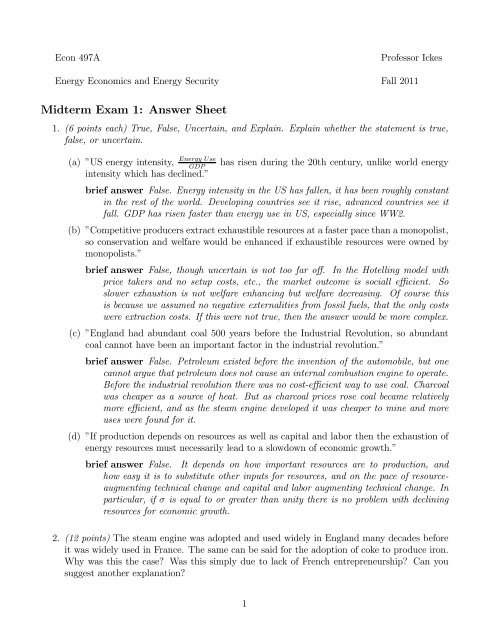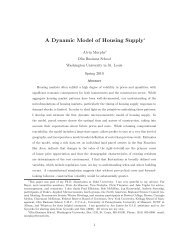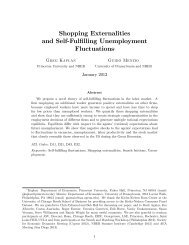Midterm Exam 1: Answer Sheet
Midterm Exam 1: Answer Sheet
Midterm Exam 1: Answer Sheet
- No tags were found...
Create successful ePaper yourself
Turn your PDF publications into a flip-book with our unique Google optimized e-Paper software.
Econ 497AEnergy Economics and Energy SecurityProfessor IckesFall 2011<strong>Midterm</strong><strong>Exam</strong>1: <strong>Answer</strong><strong>Sheet</strong>1. (6 points each) True, False, Uncertain, and Explain. Explain whether the statement is true,false, or uncertain. (a) ”US energy intensity, has risen during the 20th century, unlike world energyintensity which has declined.”brief answer False. Energy intensity in the US has fallen, it has been roughly constantin the rest of the world. Developing countries see it rise, advanced countries see itfall. GDP has risen faster than energy use in US, especially since WW2.(b) ”Competitive producers extract exhaustible resources at a faster pace than a monopolist,so conservation and welfare would be enhanced if exhaustible resources were owned bymonopolists.”brief answer False, though uncertain is not too far off. In the Hotelling model withprice takers and no setup costs, etc., the market outcome is sociall efficient. Soslower exhaustion is not welfare enhancing but welfare decreasing. Of course thisis because we assumed no negative externalities from fossil fuels, that the only costswere extraction costs. If this were not true, then the answer would be more complex.(c) ”England had abundant coal 500 years before the Industrial Revolution, so abundantcoal cannot have been an important factor in the industrial revolution.”brief answer False. Petroleum existed before the invention of the automobile, but onecannot argue that petroleum does not cause an internal combustion engine to operate.Before the industrial revolution there was no cost-efficient way to use coal. Charcoalwas cheaper as a source of heat. But as charcoal prices rose coal became relativelymore efficient, and as the steam engine developed it was cheaper to mine and moreuses were found for it.(d) ”If production depends on resources as well as capital and labor then the exhaustion ofenergy resources must necessarily lead to a slowdown of economic growth.”brief answer False. It depends on how important resources are to production, andhow easy it is to substitute other inputs for resources, and on the pace of resourceaugmentingtechnical change and capital and labor augmenting technical change. Inparticular, if is equal to or greater than unity there is no problem with decliningresources for economic growth.2. (12 points) The steam engine was adopted and used widely in England many decades beforeit was widely used in France. The same can be said for the adoption of coke to produce iron.Why was this the case? Was this simply due to lack of French entrepreneurship? Can yousuggest another explanation?1
ief answer Charcoal was relatively cheaper in France than England, and real wages werehigher in England than France. So a labor-saving innovation that was capital intensivewas more likely to be adopted in England. Only when it improved enough to be moreefficient with regard to all inputs would it be profitable to adopt in other countries. Noticethat the steam engine was only initially adopted right next to coal mines where the coalwas cheapest.3. (20 points) How can a competitive market comprised of many independent resource producersreproduce the equilibrium price and output paths that would be chosen by a social planner?brief answer Competitive producers care about profit. So they will leave oil in the ground ifthe marginal rent is expected to grow faster than the rate of interest. But they will producenow, if they expect rent to grow slower than the rate of interest. So their incentives aresuch that they will produce in a way that leads the growth rate of rent to be equal to therate of interest. So if the rate of interest is the same as the planners’ discount rate, theywill produce such that prices grow at the same rate as in the social planners’ solution(but see part a).(a) How is it possible that the competitive producers will choose production paths that willresult in the same time to exhaustion that a social planner maximizing social welfarewould choose?brief answer We have shown above that marginal rent grows at the same rate as the(rate of interest, as in the planners’ solution. That is, −)−( −1 −) −1= . Now−suppose, that the competitive producers choose too high an initial price. Then initialproduction is too low, and since price grows at the same rate as in the planners’solution, and as the planner exhausts the resource at time , the competitive soultionwould leave oil in the ground, which is not profitable. So the price of oil in period would be too low, and would induce faster production in earlier periods. Thus theinitial high price is not an equilibrium. If 0 were too low, on the other hand, oilwouldbeexhausedbefore , causing prices to rise too fast in the future, which wouldinduce less production, which would mean that current prices would have to rise. Sothe profit motive of the producers is sufficient to reproduce the correct initial price.extra This is such a neat argument, I cannot help writing more. Suppose that we werenot on the correct path; for example, let initial production be too low so that rentsin period 0, 0 0 0 on the optimal path as in figure 1. Then we can see that at 0when → not all of the resource is depleted. The resource owners are expectingthe price to rise above , which is not possible. So producers would want to producemore at 0 − 1, which would lower the price then. But then the price at 0 − 2 is notoptimal. Hence this path cannot be optimal.more extra The same type of argument would hold if the path were too low. In thatcase we would deplete the resource before reached , which means that the pricewould jump before exhaustion, so producers would want to save by holding resourcesin the ground, and the path would unravel. The force that is satisfying the terminalcondition are the expectations of the producers — perfect foresight in fact. Of course,we cannot expect all producers to have perfect foresight, but independent producers2
poptimal pricepathcR0}R00} R (1 r)0 1 2T TtimeFigure 1: An Alternative Price Pathcan buy and sell from each other too. If some producers have faulty foresight someothers will sign contracts to buy from them. Those with better foresight will makemoney. Later we will deal with uncertainty.(b) Suppose that the rate of interest is higher than the discount rate which a social plannerwould use (that is, society’s discount rate, ). How will the production path producedby the market compare with the social optimum? Explain.brief answer The competitive market will produce more in the current period and marginalrent will grow faster than the social planner would have it. So the resource willbe exhaused sooner. There is greater production and earlier exhaustion if .4. (14 points) ”Modern production in developed economies is heavily dependent on energy ascompared with pre-industrial economies. Standards of living have expanded enormously sincethe Industrial Revolution. Yet, energy resources have become more abundant over the last150 years.” Does this statement make sense? Explain carefully. What does this imply abouteconomic growth possibilities in modern economies that rely on exhaustible energy resources?Explain.brief answer The statement is true, so I guess it must make sense! Energy resources havebecome more abundant because economic incentives to discover resources are greater nowthan before the industrial revolution. Economic abundance is not the same as geologicalabundance. It is not that more petroleum is ”grown” over time. But that we find more,and we find better ways of getting it out of the ground (you could think about the Marcellusshale if you want). Before the demand for energy grew nobody searched for petroleum ornatural gas. As prices rise (see Hotelling rule) people have incentives to look for moreresources. Moreover, the efficiency with which energy is uses has also increased — modernjets are more efficient than old propeller planes, so we get more economic value out of thesame resources. Both factors work to increase abundance. Technological change helps uscope with exhaustible resources.5. (30 points) Consider the basic Hotelling model of exhaustible resources. Assume a competitiveeconomy with many producers, a fixed cost of extraction, , and a choke price, . The rate ofinterest is given at rate . Carefully explain what happens to the current price of the resourceand the time to depletion, if:3
(a) the rate of interest increases.brief answer A higher interest rate raises the incentive to produce today. It also makesmarginal rent grow faster according to the Hotelling rule. So we produce more today,so current price falls, and fallsaswell.(b) the cost of extraction is reduced due to a technical improvement discovered in period 0brief answer The technical change causes the cost of extraction to be 0 .Welearnthis in period 0 . The old path cannot be optimal from this point forwards. Notice thatthe present value of the deposit is now higher. What happens? Obviously, producerswant to produce more in the current period, so 0 ↑ and 0 ↓. Now has not changedso we know that we now have( 0 +1 − 0 ) − ( 0 − 0 )( 0 − 0 )= (1)that is, the Hotelling rule still applies. But if we consume more in period 0 and ifprices grow at the rate of interest we will exhaust the deposit before period ,sothenew time of exhaustion must be smaller 0 . Clearly, if is higher in each period (after 0 ) it must take less time to exhaust the stock.(c) a tax on net rent equal to, per barrel is imposed on producers.brief answer Let be the tax rate levied on mineral rents, − . Then the arbitragecondition is now:( − )[1− ] = (1− ) +1 − (2)1+( − ) = +1 − 1+since rent is taxed the same way in each period. But you can see that the 1 − terms cancel in this expression, so we have the same condition as before. Hence, therent tax will not effect the time path of extraction. The deposit owner cannot avoidtaxes by altering the time path of production. So the rent tax is neutral. Notice thatthe rent tax is only neutral with regard to existing production. It will have effect onthe discovery of new deposits. A rent tax will reduce the return to exploration: theexpected payoff from discovering a new deposit obviously declines with the tax.d. a new discovery of oil takes place that doubles reserves. What would the price path looklike if there were frequent discoveries of new reserves that were unexpected?brief answer Suppose it is discovered at time 0 . Then the old path can no longer beoptimal. If prices did not change we would reach the choke price with oil left in theground. So current price must fall and current production rise. But since interestrates are unchanged marginal rent will grow at the same rate, so we need a lowerinitial price and a larger 0 to exhaust all the deposit. Suppose that this discoveryhappened at some , 0 . Then at this point the price must jump down.The new information is incorporated and then prices must rise at the rate of interest.The jump happens when the news is incorporated. If this happened several times, wewould see a saw-tooth pattern to oil prices, prices falling with each new discovery.4
ppa'p 2c 2cdd'p 1c 1ab b'T 1T 2T TFigure 2: Two Different Deposits with Different Extraction Costs(d) Suppose there are two deposits, where the only difference is that the extraction costsdiffer, 0. How will production take place? What does the price path look like fromthedateoffirst production, 0 until ?brief answer The low-cost deposit is exhausted before the second deposit starts producing.Marginal rent must still grow at the same rate of interest. Say one deposit has 0 , but let them both sell for . Think of oil bubbling in Texas in 1901 versus oilunder the North Sea. Both deposits cannot produce at the same time. Oil sells for, but the net prices will differ. Soonlyonedepositwillproduceatfirst, obviouslythe low cost oil. Then as the net price rises at rate eventually the first depositis exhausted, just at the point when the net price equals the cost of extracting thehigh-cost deposit. At that point the second deposit takes over. Extraction is thussequential. Notice that at we have ( )=0. In figure ?? at that point the firstdeposit would have rent = − 1 (= 0 0 ), and the second deposit would have rent= − 2 (= 0 0 ). To see that both deposits could not be simultaneously operating,note that if they were, then working back from we can see that the discounted rentcannot simultaneously be the same for each deposit with different extraction costs andthe same market price. Note, that if 0 is followed rents for deposit 1 will not befalling fast enough from to reach point . Notice that the price path is ”scalloped”at 2 , but it is still continuous. There is no jump in . This is a very importantpoint, but note that if prices are not set competitively — a cartel like OPEC — thenthis result will not hold. We will come to that point later.5
















